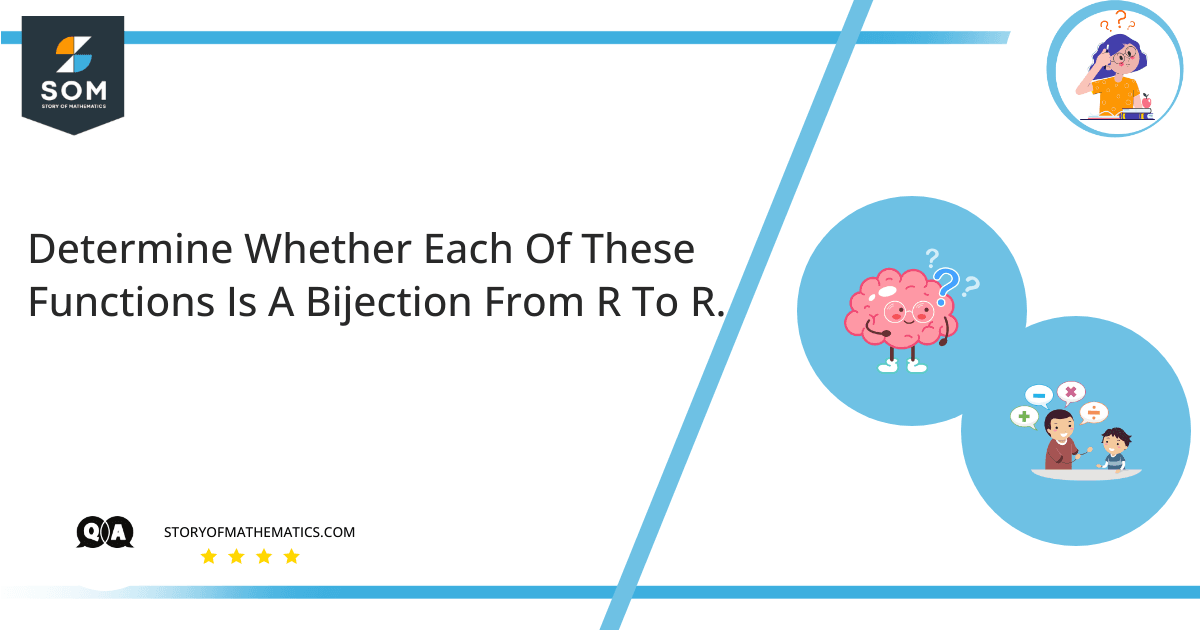
- $f(x)= −3x+4$
- $f(x)= −3(x)^2+7 $
- $f(x)= \dfrac{x+1}{x+2}$
- $f(x)= (x)^5 + 1$
This question aims to find which of the above-mentioned functions is a bijection from R to R.
A bijection is also known as a bijective function or one-to-one correspondence. A function is called a bijective function if it fulfills the conditions of both the “Onto” and “One-to-one” functions. For a function to be bijective, every element in the codomain must have one element in the domain such that:
\[ f(x) = y \]
Here are some properties of the bijective function:
- Each element of the domain $X$ must have one element in the range $Y$.
- Elements of the domain must not have more than one image in the range.
- Each element of the range $Y$ must have one element in the domain $X$.
- Elements of the range must not have more than one image in the domain.
To prove that the given function is bijective, follow the steps mentioned below:
- Prove that the given function is an Injective (One-to-one) function.
- Prove that the given function is a Surjective (Onto) function.
A function is said to be an Injective function if each element of its domain is paired up with only one element in its range.
\[ f(x) = f (y) \]
Such that $x = y$.
A function is said to be a Surjective function if every element of the range $Y$ has correspondence to some element in the domain $X$.
\[ f(x) = y \]
Expert Answer:
For the given options, let’s find out which one of them is a bijective function.
Part 1:
\[ f(x)= −3x+4 \]
Firstly, let’s determine whether it is an injective function or not.
\[ f(y) = -3y+4 \]
\[ f(x) = f(y) \]
\[ x = y \]
Thus, it is a one-to-one function.
Now, let’s check if it is a surjective function or not.
Find out the inverse of the function:
\[ f(-x) = -f(x) \]
\[ f(-x) = -(-3y+4) \]
So, it is also a surjective function.
Therefore, part 1 is a bijection function.
Part 2
\[ f(x)= −3(x)^2+7 \]
It is not a bijection function as it is a quadratic function. A quadratic function can not be a bijection.
Moreover, \[ f(-x) \neq -f(x) \]
Therefore, part 2 is not a bijection function.
Part 3:
\[ f(x)= \dfrac{x+1}{x+2} \]
It is also not a bijection function as there is no real number, such that:
\[ f(x)= \dfrac{x+1}{x+2} = 1 \]
Also, the given function becomes undefined when $x = -2$ as the denominator is zero. A bijective function must be defined for every element.
Therefore, part 3 is not a bijection function.
Part 4:
\[ f(x)= (x)^5 + 1 \]
It is an increasing function.
Therefore, part 4 is a bijection function.
Example:
Determine whether each of these functions is a bijection from R to R.
\[ f(x)= 2x+1 \]
\[ f(x)= (x)^2+1 \]
For part 1:
\[ f(x)= 2x+1 \]
Let a and b \in \mathbb{R}, so:
\[ f(a) = f(b) \]
\[ 2a+1 = 2b+1 \]
\[ a = b \]
Hence, this is an injective function.
Since the domain of this function is similar to range, therefore it is also a surjective function.
This function is a bijection function.
For part 2:
\[ f(x)= (x)^2+1 \]
It is a quadratic function.
Therefore, it is not a bijection function.
